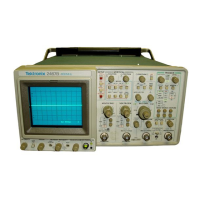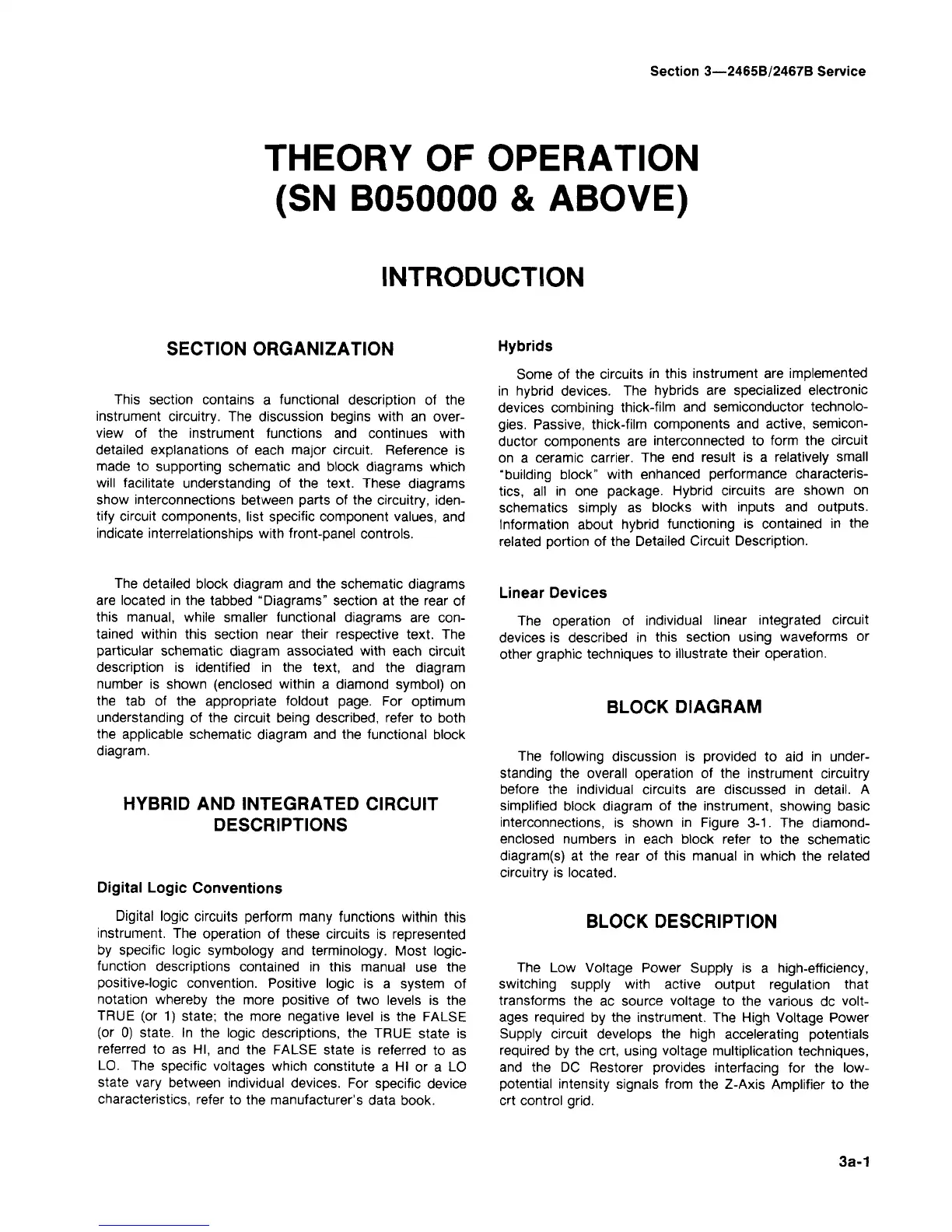Section 3—2465B/2467B Service
THEORY OF OPERATION
(SN B050000 & ABOVE)
INTRODUCTION
SECTION ORGANIZATION Hybrids
This section contains a functional description of the
instrument circuitry. The discussion begins with an over-
view of the instrument functions and continues with
detailed explanations of each major circuit. Reference is
made to supporting schematic and block diagrams which
will facilitate understanding of the text. These diagrams
show interconnections between parts of the circuitry,
iden-
tify circuit components, list specific component values, and
indicate interrelationships with front-panel controls.
The detailed block diagram and the schematic diagrams
are located in the tabbed "Diagrams" section at the rear of
this manual, while smaller functional diagrams are
con-
tained within this section near their respective text. The
particular schematic diagram associated with each circuit
description is identified in the text, and the diagram
number is shown (enclosed within a diamond symbol) on
the tab of the appropriate foldout page. For optimum
understanding of the circuit being described, refer to both
the applicable schematic diagram and the functional block
diagram.
HYBRID AND INTEGRATED CIRCUIT
DESCRIPTIONS
Digital Logic Conventions
Digital logic circuits perform many functions within this
instrument. The operation of these circuits is represented
by specific logic symbology and terminology. Most logic-
function descriptions contained in this manual use the
positive-logic convention. Positive logic is a system of
notation whereby the more positive of two levels is the
TRUE (or 1) state; the more negative level is the FALSE
(or 0) state. In the logic descriptions, the TRUE state is
referred to as HI, and the FALSE state is referred to as
LO.
The specific voltages which constitute a HI or a LO
state vary between individual devices. For specific device
characteristics, refer to the manufacturer's data book.
Some of the circuits in this instrument are implemented
in hybrid devices. The hybrids are specialized electronic
devices combining thick-film and semiconductor technolo-
gies.
Passive, thick-film components and active, semicon-
ductor components are interconnected to form the circuit
on a ceramic carrier. The end result is a relatively small
"building block" with enhanced performance characteris-
tics,
all in one package. Hybrid circuits are shown on
schematics simply as blocks with inputs and outputs.
Information about hybrid functioning is contained in the
related portion of the Detailed Circuit Description.
Linear Devices
The operation of individual linear integrated circuit
devices is described in this section using waveforms or
other graphic techniques to illustrate their operation.
BLOCK DIAGRAM
The following discussion is provided to aid in under-
standing the overall operation of the instrument circuitry
before the individual circuits are discussed in detail. A
simplified block diagram of the instrument, showing basic
interconnections, is shown in Figure 3-1. The diamond-
enclosed numbers in each block refer to the schematic
diagram(s) at the rear of this manual in which the related
circuitry is located.
BLOCK DESCRIPTION
The Low Voltage Power Supply is a high-efficiency,
switching supply with active output regulation that
transforms the ac source voltage to the various dc volt-
ages required by the instrument. The High Voltage Power
Supply circuit develops the high accelerating potentials
required by the crt, using voltage multiplication techniques,
and the DC Restorer provides interfacing for the low-
potential intensity signals from the Z-Axis Amplifier to the
crt control
grid.
3a-1

